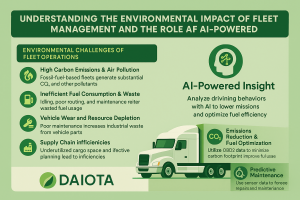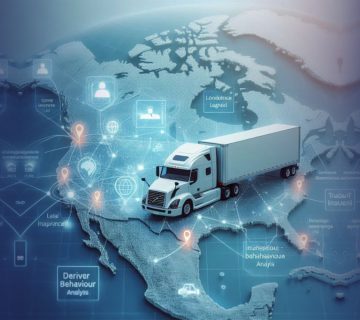📌 The Environmental Cost of Fleet Operations
Fleet management plays a critical role in global transportation, logistics, and supply chain operations, but it also significantly contributes to carbon emissions, fuel consumption, and resource waste. The transportation sector accounts for nearly 25% of global CO₂ emissions, with commercial fleets being a major contributor (Source: IEA, 2023).
As businesses face increasing environmental regulations and consumer demand for sustainability, Artificial Intelligence (AI) is emerging as a powerful tool to optimize fleet efficiency, reduce emissions, and promote greener logistics.
In this article, we explore the environmental challenges of fleet management and how AI-driven solutions are paving the way for a more sustainable future.
🔹 1. The Environmental Challenges of Traditional Fleet Management
🚛 1. High Carbon Emissions & Air Pollution
- Fossil fuel-based fleet operations produce large amounts of CO₂, NOx, and particulate matter (PM2.5).
- Heavy-duty diesel trucks alone account for over 60% of transportation-related emissions (Source: EPA, 2023).
⛽ 2. Inefficient Fuel Consumption & Waste
- Idling, inefficient routing, and poor vehicle maintenance lead to excessive fuel use.
- Studies show that up to 30% of fuel consumption in fleets is wasted due to inefficient driving patterns.
🛠️ 3. Vehicle Wear and Resource Depletion
- Poor maintenance increases the replacement rate of vehicle parts, contributing to industrial waste.
- Older, high-emission vehicles consume more fuel and generate greater carbon footprints.
🏭 4. Supply Chain Inefficiencies
- Underutilized cargo space and inefficient dispatching contribute to more trips and fuel consumption.
- Ineffective planning leads to higher operational costs and unnecessary emissions.
📌 Addressing these challenges requires a shift toward AI-driven sustainability solutions that optimize fleet operations while reducing environmental impact.

2. How AI is Revolutionizing Sustainable Fleet Management
🚀 1. AI-Powered Route Optimization Reduces Emissions
🔹 AI dynamically adjusts routes based on real-time traffic, weather, and vehicle conditions.
🔹 Machine learning identifies historical traffic patterns to reduce fuel consumption.
🔹 Studies show AI-optimized routing can lower CO₂ emissions by 20% (Source: MDPI, 2024).
📌 Example: UPS’s AI-powered route optimization (ORION) saved 10 million gallons of fuel annually, reducing carbon emissions by 100,000 metric tons per year (Source: UPS Sustainability Report).
⛽ 2. AI-Driven Fuel Efficiency Monitoring
🔹 AI analyzes engine performance, driver behavior, and fuel efficiency trends.
🔹 Detects fuel-wasting habits like harsh acceleration, idling, and inefficient braking.
🔹 Fleets using AI-driven fuel monitoring have seen fuel savings of 15-25% (Source: IEEE, 2023).
📌 Example: AI-driven fleet tracking helped DHL reduce fuel costs by 20%, cutting CO₂ emissions across their global operations.
🛠️ 3. Predictive Maintenance for Sustainable Fleet Longevity
🔹 AI predicts engine failures and wear-and-tear before they cause breakdowns.
🔹 Ensures optimal tire pressure, fluid levels, and battery health for fuel efficiency.
🔹 AI-driven predictive maintenance has been shown to increase vehicle lifespan by 40%, reducing industrial waste (Source: MDPI, 2024).
📌 Example: AI-driven diagnostics in Tesla’s electric fleet optimize battery performance, increasing longevity and sustainability.
♻️ 4. AI-Assisted Transition to Electric and Hybrid Fleets
🔹 AI identifies the best fleet segments for electrification based on route length, charging infrastructure, and operational cost.
🔹 AI-powered energy management ensures optimized EV charging schedules, reducing strain on grids.
🔹 Companies using AI for EV transition have reported 25% lower fleet emissions within five years (Source: World Economic Forum, 2023).
📌 Example: Amazon’s AI-powered EV adoption strategy helped them integrate 100,000 electric delivery vans, reducing emissions by 4 million metric tons annually.
🏭 5. AI in Supply Chain Sustainability
🔹 AI-powered cargo optimization reduces empty miles and maximizes truckload efficiency.
🔹 Smart warehouse-to-truck coordination minimizes fuel wastage from unnecessary stops.
🔹 AI-driven logistics efficiency lowers supply chain-related emissions by 15-30% (Source: McKinsey & Company, 2024).
📌 Example: AI-driven inventory tracking at Walmart optimized supply chain logistics, reducing transportation emissions by 30% in five years.
🔹 3. The Future of AI-Driven Sustainable Fleet Management
🌍 1. AI-Powered Carbon Footprint Tracking → Fleets will have real-time CO₂ dashboards for emissions monitoring.
⚡ 2. Fully Automated Eco-Driving Coaching → AI will provide instant feedback to improve driver habits.
🔋 3. AI-Optimized EV Charging Networks → Smart energy grid integration for sustainable electric fleets.
📡 4. Blockchain & AI for Carbon Credit Trading → Fleet operators can track and trade sustainability credits for financial incentives.
📌 The next decade will see AI becoming the backbone of sustainable logistics, ensuring cleaner, smarter, and greener transportation worldwide.
🚀 Conclusion: AI is the Key to Greener Fleet Management
Embracing AI-driven fleet optimization is no longer optional—it’s a necessity for:
✅ Reducing carbon emissions and fuel waste.
✅ Lowering operational costs through efficiency improvements.
✅ Transitioning fleets to sustainable, AI-managed EV networks.
Businesses that integrate AI-powered sustainability solutions today will not only reduce environmental impact but also increase profitability and regulatory compliance.
📢 Want to make your fleet operations greener?
💡 Contact DAIOTA today and explore how AI-driven solutions can revolutionize your fleet’s sustainability strategy.
🚛 The future of fleet management is green, efficient, and AI-powered! 🌍🚀
Understanding the
Environmental Impact of Fleet Management and the Role of AI 🚛




No comment